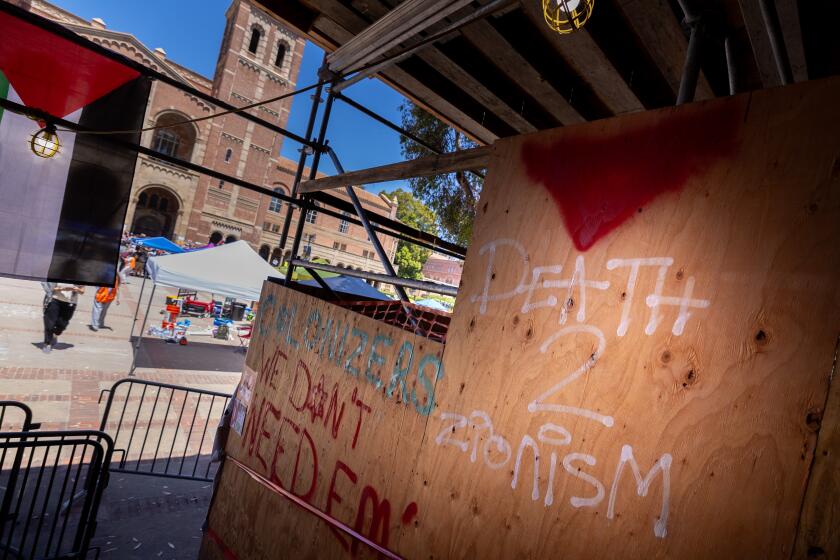REGIONAL REPORT : Cutting Classes : Budget Cutbacks Shut Out Thousands of Students From College Courses
Victor DellaRipa got into only two of the five classes he requested for this fall semester at Cal State Northridge. That was upsetting, but certainly not surprising at a campus that is offering 536 fewer classes than last year, down about 10% because of spending cuts throughout the Cal State system.
Now on the waiting list for filled classes, DellaRipa has to hope that other students will drop courses or that professors will waive enrollment limits when the semester begins Monday.
“You go to school to get an education and that’s already hard enough,” said the sophomore from Van Nuys who is a radio-television-film major. “Getting classes should be the least of your problems.”
It is a huge problem this year as recessionary budgets are hitting California’s public higher education like a police raid on a fraternity party.
At Cal State and community college campuses around the state, hundreds of professors, mainly part-timers, have been laid off and thousands of classes have been canceled.
Moreover, with the impact of the recession and large fee increases at UC and Cal State, students are scrambling for cheaper classes at already crowded community colleges. An educational gridlock appears certain to delay graduations and shut some students out altogether.
“There is nothing good to say about the effect on educational quality on our campuses, given the financial situation,” said Barry Munitz, the new chancellor of the 20-campus, California State University system. “I think there is a very fundamental public policy question as to whether we can fulfill our mission at a reasonable level of quality at the current resource base.”
The 380,000-student Cal State system’s operating budget dropped $60 million to $1.647 billion this year, Munitz said. That was after a 20% fee increase to $936 for full-time students who are California residents, not including books, living expenses or activities charges. At such Cal State campuses as Long Beach, San Diego, Los Angeles and Fullerton, class schedules are being cut between 5% and 15%.
At Cal State Fullerton, administrators are still grappling with a budget deficit that is now projected at $16 million and may climb higher, according to Norma Morris, staff assistant to President Milton A. Gordon.
To cope with the budget crisis, the campus will not fill 132 faculty positions or 35 administrative and support jobs, and an estimated 200 of 700 part-time contract lecturers may not return.
What it means for students is there will be 200 fewer classes, about 5% less than last fall and a shift in emphasis to larger, lecture-style classes. And for the first time in years, Fullerton will offer 7 a.m. and Saturday morning classes to maximize lecture-hall space.
Students also are being limited to fewer classes to “spread the grief,” in the words of one campus official. In the School of Business and Administration, where demand is greatest, students will be held to a maximum of 14 units. Elsewhere, the limit is 16 units. The only exceptions are students scheduled to graduate in January, and those in credential programs.
In another first, Fullerton officials also are predicting a drop in enrollment of as much as 7% this fall, this at a campus where demand has been high and because of space limitations enrollments have been allowed to grow only a few percentage points annually.
Among the reasons cited for the projected drop in enrollment is the 20% increase in student fees and the difficulty in getting classes.
At Cal State Northridge, here is some of the resulting bad news provided by campus officials:
* About 12,600 Northridge students got bumped from at least one class they requested, 2,100 more than last year. Of those, 516 got no courses at all in the first round of registration. How many eventually receive full schedules will not be known for weeks, until the confused add-drop activity settles down and professors respond to students’ pleas for course entrance.
* The equivalent of 80 full-time teaching slots have been eliminated from the 1,700-member faculty. However, the actual number of laid-off teachers will probably be higher because many of them taught only part time.
* Overall enrollment may decline 1% to 2% from last year’s 30,600 as discouraged students drop out or transfer.
* The average student already takes more than five years to earn an undergraduate degree and that may rise to six years. DellaRipa fears it may take him seven years to complete his degree, mainly because of the difficulty in obtaining classes.
Donald Bianchi, acting vice president for academic affairs at Cal State Northridge, contends that the “vast majority” of students would be able to proceed smoothly with their studies if they sought curriculum counseling. He conceded that many students will not do that and are resigned to taking an extra semester or summer classes.
“You can’t really call the California State University a four-year institution any longer,” said David Weiss, student government president at Northridge. “It’s almost impossible to graduate in four years because there are not sufficient number of classes offered. . . . Students are very frustrated. Here we’re paying more in student fees and getting far less than in the past.”
The frustration level will be high this week when the semester begins at Cal State campuses in Northridge, San Diego, San Marcos and Dominguez Hills. Students will show up at classes even though they were not enrolled at registration. In the unpleasant tradition called “crashing,” they will be begging professors to enroll them.
“You just have to show up early and attempt to get in. It’s really difficult,” said Northridge sophomore Tod Goldberg. Even after a schedule repair day last week, he needs one more course compatible with his work schedule as a part-time law clerk. Goldberg will be racing back and forth this week between an English class and a religious studies course, hoping to land a seat.
Professors feel the pressure. “It makes them the villains in this piece because they are the ones who have to say no directly to the students. It is really very, very unpleasant,” said Albert Baca, the Latin and mythology professor who is chairman of the Northridge Faculty Senate.
As it is, some of Baca’s courses designed for 30 students now have 45. So he assigns fewer papers or essay tests, relying more on multiple choice and true-or-false testing to cope with the extra bodies. “At some point, you just have to say: ‘I can go this far but can’t go any farther,’ ” Baca said. “You can’t have students sitting on the floor or in the hallway.”
Cal State officials estimate that the average class size will increase from 25 to 30 this year.
Kathy Zumello was one of more than 1,100 San Diego State students who received none of the classes they wanted during the first round of registration. She later managed to pick up classes in oceanography and cultural pluralism, but no English classes that count for her major requirements. So she also enrolled at Mesa Community College for English literature and Spanish courses.
“It’s inconvenient, but I’m going to do what I have to do to get my degree. They don’t give you much choice,” said Zumello, who also also has a full-time job.
For some, community colleges’ low fee of $60 a semester is attractive during hard economic times, adding to enrollment pressure.
The California Postsecondary Education Commission, which studies trends, suggests that the fee increases at UC and Cal State could force 12,900 students statewide into less expensive schools or out of school.
Ann Reed, vice chancellor for public affairs at the 1.5 million student community college system, said: “There really is a domino effect here.”
Statewide funding for the 107 community colleges was not cut but is not keeping up with the expected 5% enrollment growth and other expenses, Reed said. As a result, about 5,000 classes are being dropped from the 179,800 last fall.
Los Angeles City College will offer the same number of classes as last year even though the number of students is expected to rise 9%, to 18,500.
“Traditionally, in times of recession and unemployment, there’s a rise in enrollment,” said college spokesman Fred Piegonski. In addition, he informally polled 70 students on a registration line the other day and found that six came to City College because they could not get the classes they needed at at a Cal State campus.
At College of the Canyons in Santa Clarita, the fall semester started last week and students were standing in hallways, hoping that instructors would let them in.
Rocky Young, deputy superintendent of education for Santa Monica City College, estimated that enrollment there would be up 5% to 10% over last year’s 24,000, although no classes will be added. “We have generally turned away people (in the past) and that is starting to occur now, much earlier than usual,” he said.
UC students will feel much less classroom effects than their friends at Cal State and community colleges. In part, that is because UC hiked annual fees 40%, to $2,274 without room and board, rather than hack at programs, officials said. In addition, UC gets more federal and private funds than the other two systems and is much less dependent on state money. Nevertheless, UC has frozen most hiring and pay raises and is trimming staff with early retirement packages.
At UCLA’s College of Letters and Science, the largest academic unit on campus, 40 out of 1,000 teaching positions are vacant because of attrition and will not be filled, said provost Raymond L. Orbach. Some small classes of five or fewer students are being dropped for the fall quarter that begins late next month. Some professors are teaching heavier loads.
“I don’t think the average undergraduate will see a difference,” Orbach said. He warned that deeper cuts could come if the state budget situation worsens.
Times staff writers Mayerene Barker, Kristina Lindgren and Jean Merl contributed to this story.
More to Read
Start your day right
Sign up for Essential California for news, features and recommendations from the L.A. Times and beyond in your inbox six days a week.
You may occasionally receive promotional content from the Los Angeles Times.







